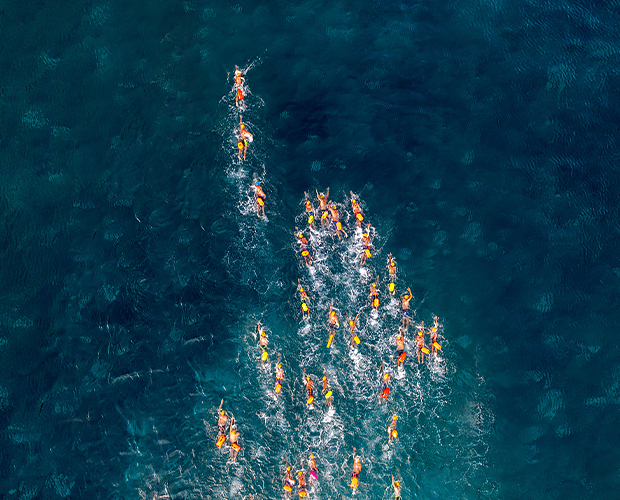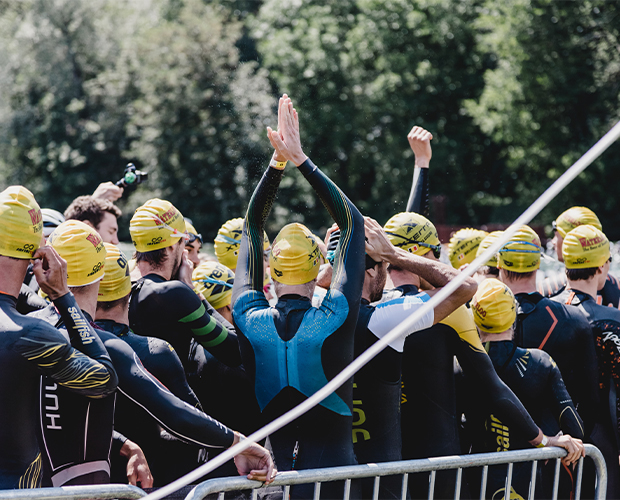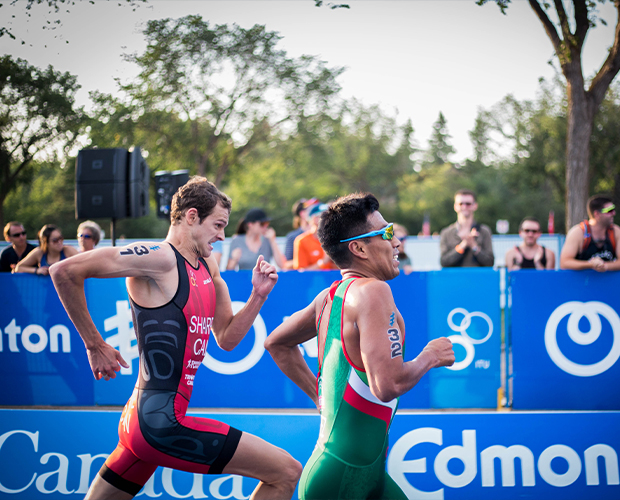A Comprehensive 70.3 Fueling Guide for First-Timers

Triathlon nutrition is essential for athletes, especially for those participating in a 70.3 race for the first time. Proper fueling can make the difference between a successful race and one marred by fatigue, cramps, or gastrointestinal distress. Nutrition is too often a black box that folks don't want to admit is an area of concern. This comprehensive guide will help you understand how to optimize your nutrition for your first 70.3 race, covering essential elements like products, water, amounts, and timing. It's time to eliminate the uncertainty.
On Carb Loading
More experienced folks can go above and beyond what is discussed here, but here are the basics for a safe carb loading procedure. You’ll get most of the benefits with virtually none of the risks.
3 Days Out: Add 100-150g carbs to whatever your typical diet would have looked like for that day of training. If you’re resting, maybe that’s 300-400g carbs. If you’re training, maybe it’s 400-600g carbs, total. Consume most of the extra carbs before 6pm so that it doesn’t disturb sleep.
2 Days Out: Add 150-250g carbs to whatever your typical diet would have looked like for the slated training. Maybe it’s 350-450g carbs total on a rest day, or 400-600g on a lighter training day.
Day Before: Add about 100-150g carbs to what is likely to be a limited training day or a light shake out. Maybe that’s 300-400g carbs.

Here’s an example for a 150 pound athlete who is doing about an hour of easy training each day leading up to their race day:
3 days out, 20 minutes swimming, 40 minutes running, all easy, 450g carbs consumed, with at least 400g consumed before 6pm.
2 days out, 60 minutes easy riding, 550g carbs with at least 450g consumed by 6pm.
Day before, rest day, 400g carbs,
If normal protein intake daily is ~130g per day, consider reducing it to ~100g per day during the carb load. If normal fat intake daily is ~90g per day, consider reducing it to 50-60 grams per day. If normal fiber intake is ~30g per day, consider keeping it there or reducing it very modestly. Just don’t chow down a high volume of fiber-rich carbs and you’ll be okay. For the duration of the carb load, stick with foods that your body is familiar with recently.
Remember, exact quantification of this stuff is highly unnecessary. If you want to get more granular about weighing out grams of nutrition, then the intra-race and intra-training fueling is a much better place to spend that time and energy. Still probably not entirely necessary, but much more useful than fussing over the specifics of daily nutrition totals or carb loading. There are time and psychology tradeoffs always. Consider wisely.
Race Day Breakfast
Target eating breakfast around 2-2.5 hours before swim warm-up starts.
Consume a meal with moderate to low protein, lower fat, limited to no fiber, very high carbs, and higher sodium. Caffeine if you like. Fluid can come from coffee, electrolyte beverage or juice. Don’t let sodium drop below 1000mg/L, total including all fluids consumed.
Example food choices: Cup of quick oats with skim milk, half cup of brown sugar, ?-¼ tsp salt. Coffee with milk and sugar to taste. Cup of apple juice or better yet, an electrolyte beverage with 1000mg sodium per liter of beverage. Up to a liter of water with breakfast.
The numbers: That might add up to 100-150g carbs, 10-20g protein, 0-10g fat, 0-5g fiber, 32oz of fluid, 1000mg sodium.
Pre-Race Hydration
Drink another 16-32oz between breakfast and racing, but don’t force it. Target 1000-2000mg sodium per liter (or per 32oz if we’re keeping the math easy). It’s okay to have another 10-20g carbs in this electrolyte beverage. Sugar & salt are great here. So are most dissolvable electrolyte tablets or hydration mixes.
If you are a first-timer and want to finish your 70.3 race safely and effectively, consider the following fueling plan. Keep in mind that this plan is based on general assumptions and may need to be adjusted according to your individual needs. I’ll lay out the safest option for the folks who are just here to finish, and an “optimal” option if you’re someone who’s more performance-focused.
Immediate Pre-Race Priming: Once you’re in your wetsuit, drink 8-24oz depending on thirst. Target 1000mg-1500mg/L sodium. 25g carbs. A gel, or sugar + salt + any flavored beverage you like will work great here. Get in the water. Get water in your suit. Do your swim warm up, if that’s allowed, and then finish any of the remaining beverage + gel combo.
Optimal Pre-Race Priming: Once you’re in your wetsuit, drink 16-24oz depending on thirst. Target 1200mg-1800mg/L sodium. 25-50g carbs. A gel or two, or sugar + salt or sodium citrate + any flavored beverage you like will work great here. Do your swim warm up, if that’s allowed, and then finish any of the remaining beverage + gel combo.

Race Fueling
Don’t waste time, or risk GI upset, by consuming anything in T1. Swim your swim, make it through transition, get on the bike with your shoes on, and your feet secure in the pedals, and get up to cruising speed. Now you’re ready for on-the-bike fueling.
On The Bike Fueling
The big three puzzle pieces you’ll notice throughout this article, are carbs, sodium, and water. It’s no different on the bike, and the bike is your time to shine when it comes to your fuel plan execution. Here are your options.
Safest Possible: Target 60-75g per hour. The reason not to do less, is if you underfuel, cramping, bonking, and fatigue and pace issues could prevent you from finishing. The reason not to do more is, if you’re inexperienced, and you mismanage your hydration, pushing carb intake rates up near or above 100g carbs per hour is more likely to cause debilitating gut issues, followed by an inability to fuel, and an inability to absorb the fuel, followed by bonking, cramping, fatigue, and pace issues. So, the 60-75g/hr range is a goldilocks optimization for this question: “what’s the most likely for all people, under all circumstances to get them across the finish line successfully?”
That same approach gives us a recommendation of about 1000 mg of sodium per liter of water consumed.
The hard part is knowing how much you’ll need to drink. If you’re small, a light sweater, and relatively fit, and it’s cool out, you might only need 400-500mL water per hour. If you’re larger, a heavier sweater, relatively unfit, or it’s warm or even hot or humid out, or all of the above, you’re going to need much more. Listen to your thirst and know that some folks do tolerate 1-1.5 L per hour of fluid on the bike. The key is to make sure your sodium intake per liter doesn’t fall.
Optimal: The major difference in the optimal performance nutrition and the safest-possible performance nutrition is carbohydrate intake. Most folks perform at their best using 90-130 grams of carbs per hour on the bike. Some very fit, and very experienced folks can benefit from as much as 150-160g per hour. Optimal for most first-timers with some time to practice their fueling, probably falls between 90-110g/hr on the bike.
The sodium and water story is just the same as the safest possible scenario. But you can push your upper limits of sodium consumption a bit more in hotter scenarios. So maybe in a cool, fit, small person it might look like 500 mL per hour with 500 mg sodium (because that’s what gives them 1000mg/L). In a hotter environment it might be ~2000mg of sodium in 1.5L water per hour, for a sodium concentration of 1333mg/L. Sodium concentrations of 1200-1800mg/L are sometimes tolerated, especially when using sodium citrate for at least half of the sodium consumed.
Run Fueling
Most folks experience some degree of dehydration on the bike, and they carry that dehydration with them onto the run. Pair that with the increase in jostling that the gut gets when you start running, and the gut tolerance for most triathletes goes down on the run, compared to the bike leg. Roughly a 20% decrease in consumption capacity is typical, but some folks can consume at almost identical hourly rates from cycling to running.
Safest Possible: To stay on the safe side, dropping fuel (carbs) intake rate from 60-75g/hr on the bike to 50-60g/hr on the run is a good idea. Consider still targeting 1000mg/L sodium on the run.
Keep in mind that your fluid intake may need to increase when you start running. There is less convective (air) cooling while you run, and in a 70.3, it’s also usually the hottest part of the race. Safe run intakes might look like 50g carbs per hour, 700mg sodium per hour and an increase in fluid intake rate from 500mL/hr to 700mL/hr.
For a 2-hour half marathon, that adds up to 100g carbs, 1400mg sodium, and 1400mL water (~48oz). The cups at most races have about 5 ounces in them.
Optimal: Even for seasoned athletes, optimal run carbs in a first-time 70.3 might drop to 70-100g/hr. Sodium should definitely stay at 1000mg/L or higher. 1500mg/L as long as sodium citrate is being used can be great too. If you’re “living off the course” usually the products on course do not use sodium citrate. Proceed with caution. Fluid intake on the run should seek to prevent dehydration here, and could easily range from 500-1200mL per hour depending on the temperatures. It’s rare for folks to be able to consume more than ~1200mL/hr while running in a 70.3.
You’ll need to listen to your gut, at all times. If it starts complaining, carb intake rate needs to be the first thing to slow down. Consumption of fluid with sodium should persist, unless you’re in gut catastrophe mode. Usually that extreme level of GI distress can be prevented by listening to earlier cues, pacing appropriately, and thermally regulating oneself (water on head anyone!?).

Now that you are thoroughly schooled in how to make a plan, it would behoove you to know that there’s an app for that.
What Are My Risks & What Do I Do If They Happen?
Finally, we're all risk mitigators at heart. We like to know what could go wrong. What are the consequences of the games we're playing here. Because of that "What happens if…" is one of the most common questions folks will ask once they start really thinking about these fueling details. So, here are the things that happen, and that you need to know while you're starting out with any numbers-based plan.
Remember, any plan has to be a living, breathing, flexible agreement you're making with your body. And you have to be able to understand your body's language to even have that conversation. Understanding the "what happens if…" is a great place to start.
First the what to do:
Fluid intake should match or slightly exceed your thirst.
Sodium concentration in fluids should increase as fluid intake increases.
Carb intake should decrease if you don't properly manage fluid and sodium intake.
“What happens if I…?”
Here are the answers to the most common "What happens if I?" questions:
–Overconsumption of fluids without sodium can lead to hyponatremia.
–Overconsumption of sodium can cause gastrointestinal distress.
–Overconsumption of carbs can also lead to gastrointestinal issues.
–Underconsumption of fluids can cause cardiac drift, faintness, fatigue, and cramps.
–Underconsumption of sodium can result in frequent urination, fatigue, swelling, and hyponatremia.
–Underconsumption of carbs can lead to fatigue, cramps, and a lack of mental focus.
–Gaps in carb consumption can cause faintness, hunger, hypoglycemia, and irritability.
–Gaps in sodium consumption are not a significant concern.
–Gaps in fluid consumption can result in stomach cramps, pain, nausea, and restricted carb intake.
Common Fueling Problems for Newbies
First-time triathletes often face these fueling challenges and end up wondering how it all went wrong. If you're in the learning stages of your nutrition journey in triathlon, keep these top of mind.
Forgetting to drink, leading to dehydration and hypoglycemia, followed by overeating and gastrointestinal pain.
Solution: consume steadily, early and often.
Not fueling adequately on the bike, resulting in a poor performance during the run.
Solution: consume steadily, early and often.
Choosing high-glucose supplements that cause gastrointestinal distress despite moderate carb consumption.
Solution: use mostly sucrose or 50-50 maltodextrin:fructose
Underconsuming sodium, leading to unsatisfied thirst and a sloshy feeling in the stomach.
Solution: put sodium in all beverages. Table salt or sodium citrate.
Relying on poorly formulated, well-marketed products that contain fat, fiber, protein, or sugar alcohols, which can negatively affect performance and cause gastrointestinal issues.
Solution: use mostly sucrose & salt or sodium citrate.
It’s time. You’ve read, you’ve learned, you’ve planned, you’ve trained, and you’ve studied the contingency plans. Go execute your plan (and plan B C & D, as needed) You now have the seasoned knowledge usually acquired through years of sometimes-anguish-filled learnings. I look forward to hearing how it went.
Dr. Alex Harrison & Michelle Howe, a pro triathlete, registered dietitian (RD) and board certified specialist in sports dietetics (CSSD), have come together with a growing team of designers and developers to create an app which quickly and easily builds professional grade fueling plans for your next 70.3.


Start the discussion at slowtwitch.northend.network